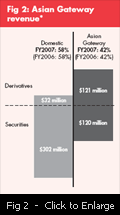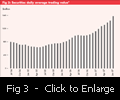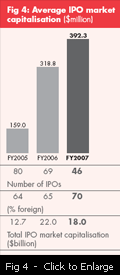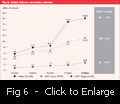SGX is increasingly recognised as an Asian financial gateway.
Our comprehensive suite of Asian-based derivatives and securities products offers international market players convenient access to the dynamic fast-growing Asian markets, and also enables our customers in Asia to gain exposure to the global market.
Foreign listings and offshore derivatives contributed 42% to our operating revenue. This demonstrates the success of our Asian Gateway strategy (Fig 2).
| The Asian Gateway is supported by three main pillars: |
| • |
Developing an Asian platform for growth companies seeking an international listing venue for their capital-raising needs, as well as for financial institutions to list structured products; |
| • |
Providing a centre for customers to manage their risk and trading needs in the Asian time zone; and |
| • |
Forging strategic partnerships and alliances to achieve greater synergies and efficiencies. This enables us to deliver a broader array of products and services with a shorter
time-to-market. |
An Asian listings platform
Riding on the strength and growth of the regional economies,
our securities markets saw significant growth with higher turnover velocity of 65% (FY2006: 58%).
The Straits Times Index (STI) closed at 3,548 on 29 June 2007. This was 18.8% above the previous year. A total of 425.7 billion
shares were traded in FY2007 (FY2006: 224.9 billion) with a daily
average trading value of $1.60 billion, a 56.9% increase from $1.02billion in FY2006 (Fig 3).
As at 29 June 2007, the total number of listed companies on SGX stood at 722 with a total market capitalisation of $773.3 billion,
up 65.9% from the previous financial year (FY2006: $466.1 billion).
A total of 120 listed companies had a market capitalisation of above $1.0 billion each, as compared to 79 a year ago.
This year saw 50 new listings1 on SGX, worth a total of $21.9 billion in market capitalisation. The average market capitalisation
of these companies2 continued to grow, from $382 million in FY2006 to $446 million in FY2007. Foreign companies contributed 70% of Initial Public Offerings (IPOs) in FY2007, up from 65% the previous year (Fig 4). This is in line with our strategic efforts to attract more foreign companies.
South East Asia listings
The year saw eight companies from South East Asia listed on
SGX. Of these, four had an IPO with a market capitalisation of above $1.0 billion each. We will continue to facilitate new listingsfrom Vietnam, Indonesia, Thailand and Malaysia.In total,
South East Asia listings accounted for 18.4% of foreign
listings (Fig 5). |




|
|
Quality listings from China
A notable characteristic of the new listings from China was the increase in their average size. As at end of FY2007, their average market capitalisation had more than doubled year-on-year, from $174.5 million to $487.8 million. The average funds raised more than tripled, from $43.4 million to $146 million.
As of 30 June 2007, a total of 116 or 16% of companies listed on SGX were from China, accounting for market capitalisation of $63 billion, as compared with $26 billion in FY2006.
The MOUs we have signed with the provincial and municipal authorities in China are reaping results. Of the 16 Chinese IPOs on SGX in FY2007, six came from provinces with whom we have MOUs. These six listings raised $1.6 billion and contributed $5.0 billion or 27.8% of the total IPO market capitalisation.
Capitalising on sectoral strengths
Singapore’s tax-friendly and supportive regulatory framework continued to spur development of the REITs sector.
In FY2007, this sector continued to attract listings from different sectors with cross-border assets. Six REITs listed on SGX during the year brought the total market capitalisation of the sector to $29.2 billion. They include CapitaRetail China Trust, the world’s largest China REIT and First REIT (sponsored by Lippo Group), the world’s first REIT in the Indonesian healthcare sector and SGX’s first-ever healthcare REIT. CDL Hospitality REIT also launched the first hotel REIT listed on SGX. Looking ahead, we anticipate more REIT listings from new regions such as India, Japan, Malaysia and Indonesia.
In addition, FY2007 saw the first Infrastructure Business Trust listing on SGX, CitySpring Infrastructure Trust (sponsored by Temasek Holdings) with an initial market capitalisation of $400.5 million. A promising sector, Infrastructure Trusts bring a new asset class to investors. As more sponsors tap on the advantages of a Business Trust to distribute cash flows, we expect to see more such listings holding Singapore and cross-border infrastructure assets.
SGX also continued to benefit from Singapore’s status as a trans-shipment hub, with four marine and offshore marine listings in FY2007. Of these, two from Europe (Rickmers and FSL) were listed as Shipping Business Trusts holding container ships, tankers and bulk carriers. This suggests that the Business Trust structure is understood and accepted by the marketplace for its strengths in distributing cash flows.
The other marine listings were Yangzijiang, one of China’s largest shipbuilders, which has performed strongly since listing in April 2007, and PT Berlian, a tanker company listed in Jakarta. The latter sought an overseas listing in Singapore to enhance its international profile and broaden shareholder base. We see a strong pipeline of marine and offshore marine listings from various geographical regions looking to capitalise on our strength and understanding of the sector.
Exchange Traded Funds
SGX added another eight ETFs to its product suite in FY2007, comprising six regional equity funds and two commodity funds. With these, SGX now covers the burgeoning major regional markets such as China, India, Taiwan, Hong Kong, Korea and Singapore. Coverage will soon expand to include other countries in the region, as well as sector-based and themed ETFs.
With the five US cross-listed ETFs whose primary listings are on American Stock Exchange (AMEX) and New York Stock Exchange (NYSE), the total number of ETFs available on SGX now stands at 16. Total value traded grew from US$40 million in FY2006 to US$518 million in FY2007, indicating the growing interest and traction in ETFs. The most popular ETF remains the iShares MSCI India ETF, which is traded by both institutional and retail participants. In FY2007, a total of US$318 million in value was traded.
Global Depository Receipts (GDRs)
The first GDR, Uttam Galva Steels from India, was listed on SGX in April 2007. We expect to see more GDR listings from India and North Asia.
Transforming SESDAQ
On 23 May 2007, SGX proposed two separate sets of rules to enhance the quality of offerings on our Mainboard and SESDAQ. These changes aim to promote investor confidence and attract more quality issuers and intermediaries, enabling us to advance our Asian Gateway position, with clearly differentiated markets.
For the Mainboard, we recommended setting up a watch-list of underperforming companies to keep investors informed of their status. Through this, we hope to galvanise such companies into improving their business and financial performance.
More in-depth improvements were recommended for SESDAQ. Established in 1987, SESDAQ has largely fulfilled its purpose of meeting the fundraising needs of local small and medium enterprises. In a recent market study, our survey of market participants’ requirements and review of other market models led us to conclude that SESDAQ must improve its offering in order to achieve further long-term growth.
In view of this, SGX proposed a new, sponsor-supervised regime for SESDAQ, with a shorter time-to-market and greater flexibility for secondary fund raising and corporate actions. Key safeguards would remain, for the alignment of management and shareholders’ interests as well as corporate governance. The changes would help transform SESDAQ into a board for both local and foreign growth companies with a scalable model. To facilitate the transition, existing SESDAQ companies will be given
at least two years to embrace the new regulatory regime.
Review of Listing Manual
As part of our ongoing efforts to keep listing rules relevant and in tandem with the growth and development of the marketplace, SGX conducted a consultation exercise in May 2007 on proposed amendments to the Listing Manual to improve transparency and market efficiency. These included proposals to allow continuous trading of cash companies, to shorten the minimum duration of trading halts to 30 minutes and to require immediate announcements of details of grants of employee share options to prevent back-dating of options.
The review underscores SGX’s commitment to operate a market-oriented, transparent and well-regulated marketplace.
Improving research coverage
Our pioneering SGX-MAS Research Incentive scheme, launched in December 2003, aims to
raise the profile of listed companies in Singapore through greater research coverage. As at
30 June 2007, there were 155 listed companies participating in the scheme. The scheme continues to attract more than 55,000 downloads of research reports per month.
Risk management centre
 Derivatives market trading volumes for FY2007 rose 10.2% over the previous financial year. Our flagship products – the Nikkei 225, MSCI Taiwan and MSCI Singapore futures contracts – continued to register impressive growth, setting new volume and open interest records. Our indigenous MSCI Singapore futures also chalked up strong growth of 48.9% (Fig 6). Derivatives market trading volumes for FY2007 rose 10.2% over the previous financial year. Our flagship products – the Nikkei 225, MSCI Taiwan and MSCI Singapore futures contracts – continued to register impressive growth, setting new volume and open interest records. Our indigenous MSCI Singapore futures also chalked up strong growth of 48.9% (Fig 6).
By October 2006, the SGX derivatives market had completed the migration from open outcry to electronic trading, a move which had begun two years earlier. We have since implemented a series of further enhancements to our market, in order to facilitate trading and risk management opportunities. These include the introduction of new matching algorithms, complex strategies and implied-out spreading to our Euroyen market. In December 2006, we also introduced extended trading hours for our derivatives products, to let market participants better manage their trading positions and capitalise
on market opportunities that might occur during European or US trading hours.
SGX and the Chicago Mercantile Exchange (CME) renewed our landmark Mutual Offset System agreement for another three years from February 2007 to 2010. The Mutual Offset System gives market participants the benefits of real-time clearing and inter-exchange transfer services, allowing market participants to execute their risk management programmes in an effective and timely manner. The agreement was first signed in 1984, and this extension underlines the importance of the Mutual Offset System to both exchanges and to the global derivatives marketplace.
In FY2007, the structured warrants market recorded a 49.3% growth in turnover value to $18.8 billion, as compared to $12.6 billion in FY2006. The number of new structured warrants listings rose 62.2% from 806 to 1,307 year-on-year. Structured warrants on regional indices and IPOs were particularly well-received by the market.
Diversifying products
To meet the different risk and investment needs of our customers, SGX remains committed to developing a diversified suite of products.
Riding on keen interest in the Japanese market, we introduced a US dollar-denominated Nikkei 225 futures contract, allowing investors more trading and arbitraging opportunities between our Yen and US dollar-based Nikkei 225 futures contracts. We also re-launched our Euroyen options with enhanced
specifications during the year. We are also exploring the introduction of a suite of mini contracts to encourage overseas and local retail participation.
On 23 September 2006, we launched the SGX FTSE Xinhua China A50 index futures. This is the first internationally available futures contract based on the largest 50 China “A” share stocks by market capitalisation.
In June 2007, SGX became the first exchange in Asia to list Certificates, when two issuers launched the Participation Certificates and Daily Lock-In Certificates, respectively. We have established a working relationship with five issue managers and are in the process of increasing this number.
Extending distribution
SGX already has a firm foothold amongst institutional traders globally. We now intend to extend our client base to include retail and online investors in the region as well. With a comprehensive suite of Asian products on a single platform, SGX aims to appeal to this customer segment by providing an attractive alternative market, offering both trading convenience and cost efficiency.
Strategic alliances
SGX continues to forge strategic alliances with overseas exchanges to strengthen our position as an Asian Gateway.
In FY2007, we signed Memoranda of Understanding (MOUs) with Korea Exchange, Abu Dhabi Securities Market, the Ho Chi Minh City Securities Trading Center and Hanoi Securities Trading Center.
SGX acquired a 5% stake in Bombay Stock Exchange (BSE) in May 2007 for US$42.7 million. We will collaborate with BSE in areas relating to listings and product development, leveraging on SGX’s leading position as a regional hub for derivatives and international listings, and BSE’s strong presence in India.
On 15 June 2007, the Tokyo Stock Exchange (TSE) announced their purchase of a 4.99%
stake in SGX, effectively endorsing our role as an Asian Gateway. TSE plans to seek approval from the Monetary Authority of Singapore to increase its stake to 5% to become a substantial shareholder in SGX. Together, SGX and TSE will study ways to collaborate, including establishing a derivatives trading and clearing link, with the initial focus on Japanese government bonds and TOPIX products.
| 1 |
includes Initial Public Offerings and Reverse Takeovers |
| 2 |
excludes 1 GDR listing |
|

